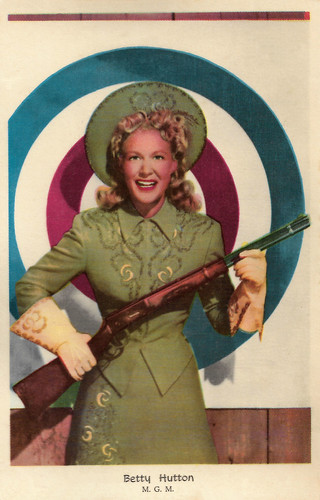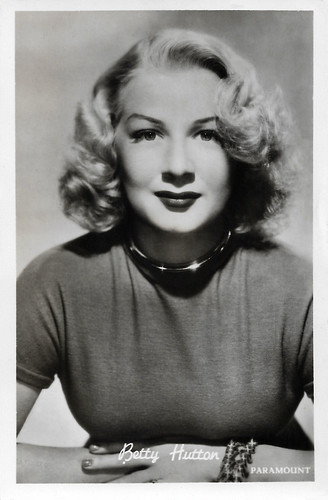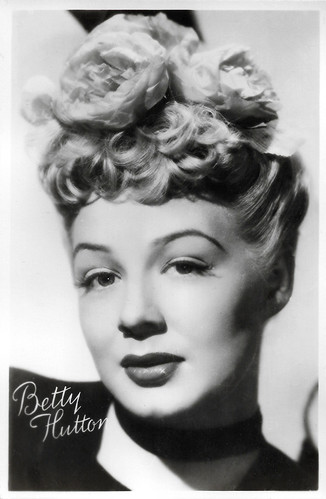
Vintage postcard. Photo: M.G.M. Betty Hutton in Annie Get Your Gun (George Sidney, 1950).

Dutch promotion card by Paramount Pictures. Photo: Paramount Pictures. Betty Hutton and Cornel Wilde in The Greatest Show on Earth (Cecil B. DeMille, 1952). Caption: Acrobatic tours in the skies of the cold-blooded Cornel Wilde and the no less skilled Betty Hutton in one of the most sensational scenes of The Greatest Show of Earth. Further protagonists are Charlton Heston, Dorothy Lamour, Gloria Grahame, and James Stewart.

British postcard in the Picturegoer series, London, no. W. 866. Photo: Metro Goldwyn Mayer. Betty Hutton in Annie Get Your Gun (George Sidney, 1950).

British postcard in the Picturegoer Series, London, no. W 252. Photo: Paramount. Betty Hutton in Dream Girl (Mitchell Leisen, 1948).

British postcard in the Picturegoer Series, London, no. W 804. Photo: Paramount.
Singing to any group that would listen
Betty Hutton was born Elizabeth June Thornburg in Battle Creek, Michigan, in 1921. She was the younger sister of Marion Hutton who later became popular as a solo singer with Glenn Miller's big band.
Two years later, Betty's father left the family and committed suicide 16 years later. Having to fend for themselves, Mrs. Thornburg moved the family to Detroit to find work in the numerous auto factories there, but times were hard. She decided to take advantage of Prohibition and opened a small tavern, at the time called a speakeasy.
At nine years old, Betty began singing publicly for the first time in a school production. Realising the voice Betty had, her mother took her around Detroit to have her sing to any group that would listen. This was a small way of getting some money for the poor family.
When she was 13, Betty got a few singing jobs with local bands in the area. Thinking she was good enough to make it big time, she left for New York two years later to try a professional career. Unfortunately, she was rejected and Betty headed back to Detroit.
In 1937, she was discovered by Vincent Lopez who had a popular band that appeared on the local radio. He ensured that Hutton got roles in two Warner Brothers short films. In 1940, she would return to New York and on Broadway, her career took off. Betty starred in the Broadway shows 'Panama Hattie' and 'Two for the Show'.

French postcard by Editions P.I., no. 329, 1954. Photo: Paramount Pictures Inc.

Vintage postcard. Photo: Filmtrust / Paramount.

Belgian postcard by Nieuwe Merksemsche Chocolaterie S.P.R.L., Merksem (Antwerp). Photo: Paramount.

Dutch postcard. Photo: Paramount.

Dutch postcard. Photo: Paramount.
Sharpshooter Annie Oakley
The following year, Betty Hutton left New York for Hollywood, where she was to find new life in films. She was signed by Paramount Pictures and made her debut, at 21, in The Fleet's In (Victor Schertzinger, 1942), along with Eddie Bracken, William Holden, and Dorothy Lamour.
Reviews were better than expected, with critics looking favourably upon her work. Hutton appeared in many films in the 1940s. These were mainly comedies and musicals. In 1944, she tried to break away from musicals and try her hand at a screwball comedy, The Miracle of Morgan's Creek (Preston Sturges, 1944).
She proved - to herself, the public, and the critics - that she was marketable outside musicals. Her most famous role was in Annie Get Your Gun (George Sidney, 1950) opposite Howard Keel. The film's screenplay is based on the 1946 musical of the same name by Herbert and Dorothy Fields and Irving Berlin.
The musical's libretto is loosely based on the life of sharpshooter Annie Oakley (1860-1926) who was part of Buffalo Bill's Wild West Show, along with her husband Frank Butler and Sitting Bull, among others. The role of Annie Oakley was originally intended for Judy Garland, but she could not play the role because of health problems. Annie Get Your Gun was a huge success in cinemas and made $8 million. The film won an Oscar for best music.
Two years later, Hutton played one of the main roles in The Greatest Show on Earth (Cecil B. De Mille, 1952) with Cornel Wilde, Charlton Heston, and James Stewart. This film about circus life was a box-office success, bringing in $14 million at the time of its release. It was also much appreciated by critics and won the Academy Award for Best Picture.

Vintage postcard, no. 247. Photo: Metro-Goldwyn-Mayer. Betty Hutton in Annie Get Your Gun (George Sidney, 1950).

Vintage postcard. Photo: Paramount.

Big Dutch postcard by 't Sticht / Takken, no. 3148. Image: Film en Toneel.

Spanish postcard, no. 2441.

French postcard by Editions P.I., Paris, no. 235, offered by Victoria, Brussels, no. 639. Photo: Paramount, 1950.
The temper tantrum-prone Betty
After filming Somebody Loves Me (Irving Brecher, 1952), Betty Hutton was all but finished. She had married Charles O'Curran that year and he wanted to direct her in an upcoming film. Paramount didn't like the idea and the temper tantrum-prone Betty walked out of her contract and movies.
She did concentrate on the relatively new medium of television and the stage, but she never recovered her previous form. Her final film was a minor one, Spring Reunion (Robert Pirosh, 1956) with Dana Andrews. Hutton could mainly be seen in nightclubs in Las Vegas and did a lot of television work.
In 1959, for example, she had her own show, The Betty Hutton Show, but it didn't fare too well at all. In the 1970s, Hutton declined sharply. She stopped getting roles and her singing talent faded. She fled to alcohol, had a nervous breakdown, and tried to commit suicide.
She died in 2007 in Palm Springs, California, of the consequences of colon cancer. She was 86 years old. The news of her death was announced at her request after the funeral.
'It's Oh So Quiet', released in 1951 as the B-side of Hutton's single 'Murder, He Says', is a cover of the German song 'Und jetzt ist es still' by Horst Winter in 1948 to music by Austrian composer Hans Lang with German lyrics by Erich Meder. The English lyrics were written by Bert Reisfeld. 'It's Oh So Quiet' was exactly replicated by Björk in 1995 and became her most successful song.

Spanish postcard by Archivo Bermejo, no. 4820. Photo: M.G.M. Howard Keel and Betty Hutton in Annie Get Your Gun (George Sidney, 1950). The Spanish title was La reina del oeste.

Small autograph card.

Small autograph card.

British postcard in the Picturegoer series, London, no. W. 868. Photo: Metro Goldwyn Mayer. Betty Hutton, J. Carrol Naish and Louis Calhern in Annie Get Your Gun (George Sidney, 1950).

American postcard.

Dutch promotion card by Paramount Pictures. Photo: Paramount Pictures. Publicity still for The Greatest Show on Earth (Cecil B. DeMille, 1952).
Sources: Denny Jackson (IMDb), Wikipedia (Dutch), and IMDb.
No comments:
Post a Comment